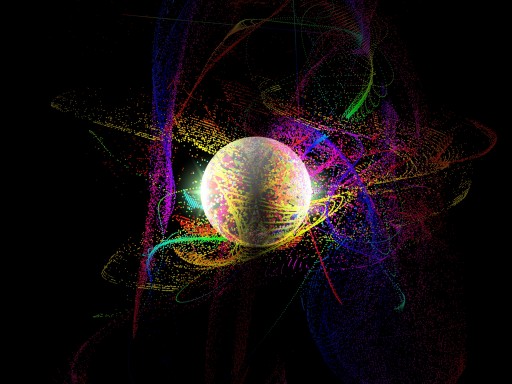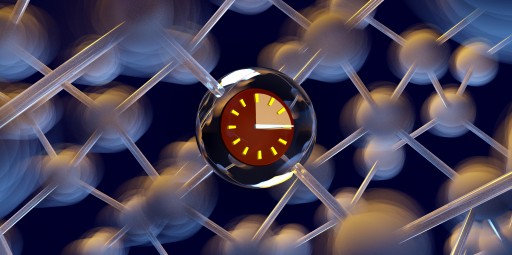Quantum world record smashed
Qubits survive at room temperature for a world-record 39 minutes
November 19, 2013
[+]
A normally fragile quantum state has been shown to survive at room
temperature for a world record 39 minutes, overcoming a key barrier
towards building ultrafast quantum computers, the researchers say.
A
normally fragile quantum state has been shown by Oxford University
researchers to survive at room temperature for a world record 39
minutes. An artistic rendition of a “bound exciton” quantum state used
to prepare and read out information stored in the form of quantum bits.
(Credit: © 2013 Stef Simmons)
(Credit: © 2013 Stef Simmons)
An international team including Stephanie Simmons of Oxford University‘s Department of Materials report in this week’s Science a test performed by Mike Thewalt of Simon Fraser University, Canada and colleagues.
Qubits survive at 25 °C for 39 minutes
[+]
In the experiment, the team
raised the temperature of a system — in which information is encoded in
the nuclei of phosphorus atoms in silicon — from -269 °C to 25 °C and
demonstrated that the superposition states survived at this balmy
temperature for 39 minutes — outside of silicon, the previous record for
such a state’s survival at room temperature was around two seconds.
The team even found that they could manipulate the qubits as the
temperature of the system rose, and that they were robust enough for
this information to survive being “refrozen” (the optical technique used
to read the qubits, which only works at very low temperatures).
A
phosphorus atom qubit in silicon can preserve quantum information for
over 3 hours at cryogenic temperatures or 39 minutes at room temperature
[credit: © 2013 Karl G. Nyman)
According to Simmons, an author of the paper, “39 minutes may not seem very long but as it only takes one-hundred-thousandth of a second to flip the nuclear spin of a phosphorus ion — the type of operation used to run quantum calculations — in theory over 20 million operations could be applied in the time it takes for the superposition to naturally decay by one percent. Having such robust, as well as long-lived, qubits could prove very helpful for anyone trying to build a quantum computer.”
“This opens up the possibility of truly long-term coherent information storage at room temperature,” said Thewalt.
How it was done
The team began with a sliver of silicon doped with small amounts of other elements, including phosphorus. Quantum information was encoded in the nuclei of the phosphorus atoms: each nucleus has an intrinsic quantum property called “spin,” which acts like a tiny bar magnet when placed in a magnetic field. Spins can be manipulated to point up (0), down (1), or any angle in between, representing a superposition of the two other states.
The team prepared their sample at just 4 °C above absolute zero (-269 °C) and placed it in a magnetic field. Additional magnetic field pulses were used to tilt the direction of the nuclear spin and create the superposition states. When the sample was held at this cryogenic temperature, the nuclear spins of about 37 per cent of the ions — a typical benchmark to measure quantum coherence — remained in their superposition state for three hours. The same fraction survived for 39 minutes when the temperature of the system was raised to 25 °C.
“These lifetimes are at least ten times longer than those measured in previous experiments,” said Simmons. “We’ve managed to identify a system that seems to have basically no noise. They’re high-performance qubits.”
There is still some work ahead before the team can carry out large-scale quantum computations. The nuclear spins of the 10 billion or so phosphorus ions used in this experiment were all placed in the same quantum state. To run calculations, however, physicists will need to place different qubits in different states.
“‘To have them controllably talking to one another — that would address the last big remaining challenge,” said Simmons.
Abstract of Science paper
Quantum memories capable of storing and retrieving coherent information for extended times at room temperature would enable a host of new technologies. Electron and nuclear spin qubits using shallow neutral donors in semiconductors have been studied extensively but are limited to low temperatures (≲10 kelvin); however, the nuclear spins of ionized donors have the potential for high-temperature operation. We used optical methods and dynamical decoupling to realize this potential for an ensemble of phosphorous-31 donors in isotopically purified silicon-28 and observed a room-temperature coherence time of over 39 minutes. We further showed that a coherent spin superposition can be cycled from 4.2 kelvin to room temperature and back, and we report a cryogenic coherence time of 3 hours in the same system.
(¯`*• Global Source and/or more resources at http://goo.gl/zvSV7 │ www.Future-Observatory.blogspot.com and on LinkeIn Group's "Becoming Aware of the Futures" at http://goo.gl/8qKBbK │ @SciCzar │ Point of Contact: www.linkedin.com/in/AndresAgostini
 Washington
Washington